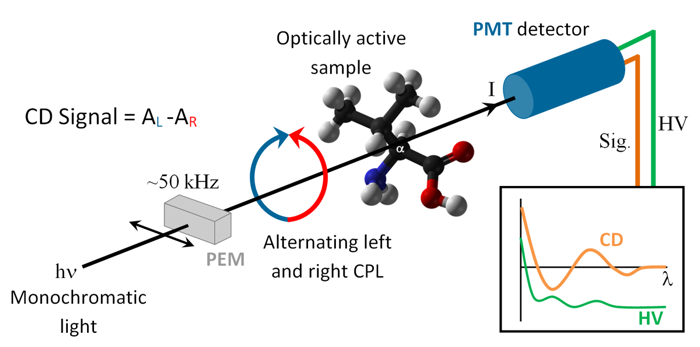ASTRID2 and the Rosetta Mission
ISA Wednesday 12th November 2014
Where do we come from? The ultimate question of life...
Research carried out using the light from ASTRID2 is playing a part in trying to understand a crucial step in the origin of life, the origin of biomolecular symmetry breaking or "homochirality". Why proteins are predominantly made up of L-amino acids (and D-sugars the backbone of DNA and RNA) is still unknown. One possible theory suggests that the process may have started in space, with the irradiation of interstellar material by circularly polarised ultra-violet light, resulting in the formation of a preponderance of L-amino acids. With an excess of one enantiomer over the other this material, delivered by meteorite and comet impacts, would then seed life on Earth.
In support of this theory, building blocks of life have already been discovered in meteorites found on Earth, and enatiomeric excess of some has already been found in meteorites such as Murray and Murchison [1]. Rosetta is the first mission to attempt landing on a comet and the onboard experiments will study the comet's pristine composition, unaffected by terrestrial contamination. One of the lander experiments, COSAC, will not only be able to detect the presence of organic material in the comet, but can also determine the chirality of the molecules.
Research on ASTRID2
The two enantiomers of a chiral molecule absorb left and right circularly polarised light in an equal and opposite way. This can be measured using circular dichroism (CD) spectroscopy, where the measured CD signal is the difference in absorbance of left and right circularly polarised light by the molecule.

CD spectra of films of differing
thickness of D- and L- Alanine. Spectra can be measured down to 140 nm using SRCD.
If circularly polarised light in space of a single handedness, i.e. either right or left circularly polarised, interacts with racemic mixtures of precursor molecules then this can not only initiate a reaction to create amino acids, but may also result in the formation of one enantiomer in excess of another.
Through study of these precursor molecules using CD spectroscopy, we will contribute to the understanding of the results expected from the Rosetta mission and ultimately to understand the origin of homochirality. [2-4]
About the Rosetta Mission
You can read all about the Rosetta Mission, Philae Lander, onboard instrumentation and aims of the mission at the ESA websites.
In the news
Below are links to articles about experiments performed at ASTRID2, how they are related to the Rosetta mission and landing on the Comet 67P/Churyumov-Gerasimenko.
In Danish
- Nedtælling til historiens første komet-landing - DR Nyheder
- Vores generations månelanding - AU Science and Technology
- Spændt dansk forsker vil finde livets oprindelse på komet - Videnskab.dk
In English
- Danish scientist hopes to find origins of life on comet - ScienceNordic
Synchrotron radiation circular dichroism
The AU-CD beam line is dedicated to Synchrotron Radiation Circular Dichroism (SRCD) experiments. SRCD spectroscopy offers significant improvements to the well-established method of conventional circular dichroism (cCD) spectroscopy. SRCD takes advantage of the high photon flux available from the ASTRID2 light source over a wide range of wavelengths, which results in higher signal-to-noise ratios and also enables the collection of data at lower wavelengths than is possible with cCD spectrometers.
The wavelength range of AU-CD (115 to 350 nm) is a biologically important wavelength region and the high degree of linear polarisation of the radiation and low level of scattered light from AU-CD makes the beam line well suited for SRCD spectroscopy of optically active macromolecules.
Circular Dichroism (CD) spectroscopy measures the difference in absorption between left and right handed circularly polarized light in chiral molecules. It is an established biophysical method probing the secondary structure (e.g. helices, beta-sheets, turns etc.) of peptides, proteins and nucleic acids which have distinct CD bands in the far-UV and VUV.

The principle behind CD spectroscopy. Monochromatised light from the AU-CD beam line is passed through a Photo Elastic Modulator (PEM) which converts the linear polarised light
into alternating left and right handed polarised light. The two polarisations are differently absorbed, and the difference in absorption is detected with a
Photo Multiplier Tube (PMT)
References
- S. Pizzarello and J. R. Cronin. Geochim Cosmochim Acta. 64(2) p329-38 (2000)
- J. H. Bredehöft, N. C. Jones, C. Meinert, A. C. Evans, S. V. Hoffmann, U. J. Meierhenrich, Chirality 26, p373-378 (2014)
- A. C. Evans, C. Meinert, J. H. Bredehoft, C. Giri, N. C. Jones, S. V. Hoffmann, U. J. Meierhenrich, Topics in Current Chemistry: Differentiation of Enantiomers II. red. / Volker Schurig. 341 p271-300 (2013)
- C. Meinert, J. H. Bredehoft J.J. Filippi, Y. Baraud, L. Nahon, F. Wien, N. C. Jones, S. V. Hoffmann, U. J. Meierhenrich, Angewandte Chemie (International Edition), 51(18) p4484-4487 (2012)
Last Modified 12 November 2014

